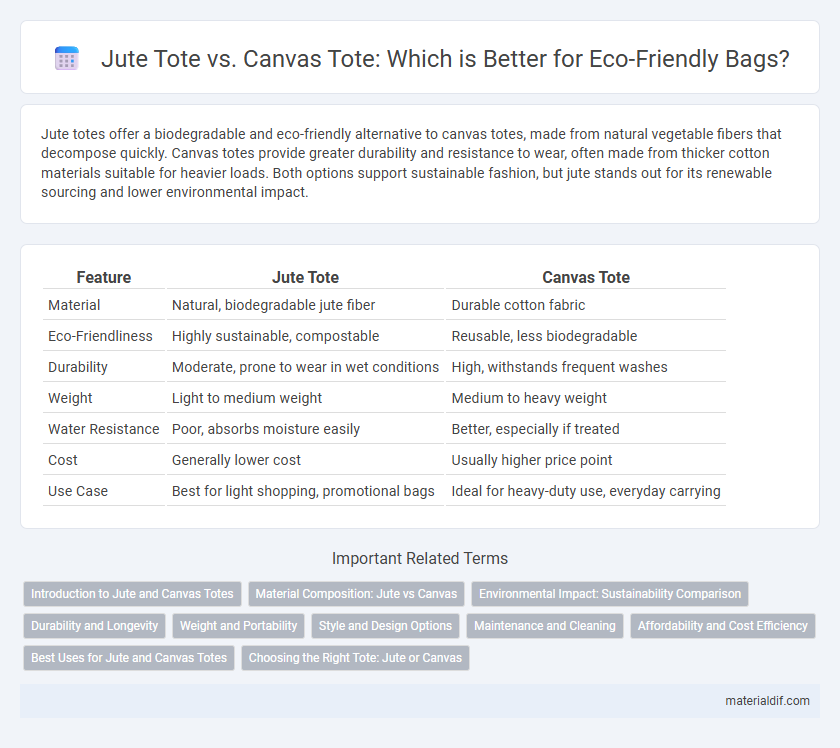Jute totes offer a biodegradable and eco-friendly alternative to canvas totes, made from natural vegetable fibers that decompose quickly. Canvas totes provide greater durability and resistance to wear, often made from thicker cotton materials suitable for heavier loads. Both options support sustainable fashion, but jute stands out for its renewable sourcing and lower environmental impact.
Table of Comparison
| Feature | Jute Tote | Canvas Tote |
|---|---|---|
| Material | Natural, biodegradable jute fiber | Durable cotton fabric |
| Eco-Friendliness | Highly sustainable, compostable | Reusable, less biodegradable |
| Durability | Moderate, prone to wear in wet conditions | High, withstands frequent washes |
| Weight | Light to medium weight | Medium to heavy weight |
| Water Resistance | Poor, absorbs moisture easily | Better, especially if treated |
| Cost | Generally lower cost | Usually higher price point |
| Use Case | Best for light shopping, promotional bags | Ideal for heavy-duty use, everyday carrying |
Introduction to Jute and Canvas Totes
Jute totes, made from natural plant fibers, offer eco-friendly durability and a rustic aesthetic, making them ideal for sustainable fashion and grocery shopping. Canvas totes, crafted from woven cotton, provide a heavier, more robust texture with versatile designs suitable for everyday use and promotional branding. Both materials are biodegradable and reusable, but jute excels in environmental impact due to its fast-growing, biodegradable nature.
Material Composition: Jute vs Canvas
Jute totes are crafted from natural plant fibers derived from the jute plant, offering a biodegradable and eco-friendly material with a coarse texture and high durability. Canvas totes are made primarily from tightly woven cotton or linen fibers, providing a smooth, sturdy fabric that is heavier and often more resistant to wear and tear. The material composition of jute emphasizes sustainability and environmental benefits, while canvas offers greater versatility in texture and printing options.
Environmental Impact: Sustainability Comparison
Jute totes offer a significantly lower environmental impact compared to canvas totes due to their biodegradable nature and minimal use of pesticides during cultivation. Canvas totes, often made from cotton, require large amounts of water and chemicals, contributing to soil degradation and higher carbon emissions. Choosing jute totes supports sustainability by promoting renewable resources and reducing the ecological footprint of everyday shopping bags.
Durability and Longevity
Jute totes offer high durability due to their natural fiber composition, making them resistant to wear and tear while remaining biodegradable. Canvas totes, crafted from tightly woven cotton, provide superior longevity with enhanced strength and resistance to frequent washing. Both materials ensure long-term reuse, but canvas totes generally withstand heavier loads and extended use better than jute.
Weight and Portability
Jute totes are lightweight due to their natural fiber composition, making them highly portable for everyday use. Canvas totes tend to be heavier and more durable but may be less convenient to carry for extended periods. The choice between jute and canvas often hinges on balancing weight and portability needs.
Style and Design Options
Jute totes offer a natural, rustic aesthetic with a coarse texture that appeals to eco-conscious consumers seeking organic style, while canvas totes provide a smoother surface suitable for intricate prints and bold colors. The versatility of canvas allows for a wider range of design options, including screen printing and embroidery, making it ideal for custom branding and vibrant patterns. Jute's limited color palette and stiffness contrast with canvas' flexibility, giving each material distinct style advantages depending on the desired look and feel.
Maintenance and Cleaning
Jute totes require gentle cleaning with mild soap and cold water to prevent fiber weakening and shrinking, while canvas totes tolerate more rigorous washing, including machine washing on gentle cycles. Jute's coarse texture and natural fibers dry slowly and can develop mold if not dried thoroughly, whereas canvas dries faster and resists mildew better. Regular maintenance of jute totes involves spot-cleaning and avoiding harsh chemicals, contrasting with canvas totes that endure frequent washing and scrubbing without significant damage.
Affordability and Cost Efficiency
Jute totes offer a more affordable and cost-efficient alternative to canvas totes due to their lower production costs and rapidly renewable fiber source. The natural durability and lightweight properties of jute reduce transportation expenses, making bulk purchases more economical for businesses. While canvas totes provide higher durability, jute's eco-friendly attributes and competitive pricing make it a preferred choice for budget-conscious consumers seeking sustainable options.
Best Uses for Jute and Canvas Totes
Jute totes excel in eco-friendly shopping and lightweight carry due to their biodegradable fibers and breathability, making them ideal for groceries, beach gear, or casual outings. Canvas totes offer superior durability and water resistance, perfect for heavier loads, daily commuting, or carrying books and electronics. Selecting between jute and canvas totes depends on the need for environmental sustainability versus long-term strength and water protection.
Choosing the Right Tote: Jute or Canvas
Choosing the right tote depends on durability, environmental impact, and intended use. Jute totes are biodegradable, lightweight, and ideal for eco-conscious consumers seeking a natural fiber option, while canvas totes offer enhanced strength, longer lifespan, and greater resistance to wear and tear for heavy-duty carrying needs. Both materials provide sustainable alternatives to plastic bags, but jute excels in compostability and breathability, whereas canvas supports repeated use and washable convenience.
Jute Tote vs Canvas Tote Infographic

 materialdif.com
materialdif.com